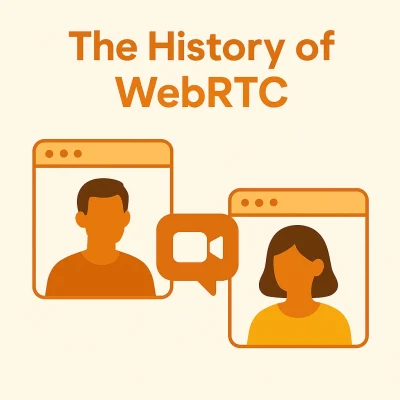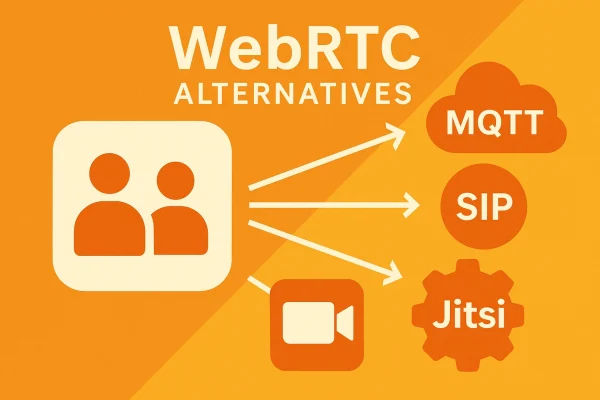Streaming audio and video over the internet has become essential for everything from live sports and gaming to virtual meetings and IoT applications. But not all streaming technologies are created equal. Two of the most widely used protocols – WebRTC (Web Real-Time Communication) and RTMP (Real-Time Messaging Protocol) – offer distinct advantages depending on your needs.
WebRTC is designed for real-time, two-way interaction. It supports ultra-low latency and peer-to-peer connections, making it ideal for video conferencing, online gaming, remote device control, and other interactive applications. RTMP, by contrast, is built for stable, high-quality broadcasting to large audiences. It typically introduces a few seconds of delay, which is usually acceptable for livestreaming events on platforms like YouTube Live, Twitch, or Facebook Live – in which the focus is on reliable delivery rather than real-time interaction.
In this post, we’ll break down the technical differences, ideal use cases, and decision factors that can help you choose the best protocol for your streaming needs.
CTA Video Demo
Key technical differences between WebRTC and RTMP
One of the biggest differences between WebRTC and RTMP is how they transmit data. WebRTC uses the User Datagram Protocol (UDP), while RTMP uses the Transmission Control Protocol (TCP). This affects both speed and reliability.
UDP is optimized for low latency. It sends packets without waiting for confirmation that they’ve been received, which speeds up transmission but can result in occasional data loss. That tradeoff makes it ideal for real-time communication, in which brief glitches are better than retransmission of outdated information.
TCP, on the other hand, ensures all data arrives in the correct order by confirming each packet’s delivery. This improves stability and video quality, but introduces more delay – which is usually acceptable in broadcasting contexts.
The protocols also differ in structure. WebRTC uses a peer-to-peer model, allowing direct communication between devices, while RTMP follows a client-server approach, sending the stream to a media server before distribution. This makes WebRTC lightweight and fast, while RTMP excels at scale.
WebRTC also includes a built-in feature called the datachannel, which enables real-time, bidirectional data transfer between peers. Developers use this not just for audio and video, but for sending control signals, telemetry, or supplemental data — making it especially powerful for interactive use cases like remote robotics, multiplayer gaming, and IoT dashboards.
Side-by-side comparison
Feature | WebRTC | RTMP |
Latency | Sub-500 milliseconds (almost real-time) | 2-10 seconds (higher latency) |
Connection Type | Peer-to-peer (direct device communication) | Client-server (stream to a central server) |
Transport Protocol | UDP (fast, minimal buffering) | TCP (stable, ensures all data is received) |
Best For | Video calls, online gaming, IoT data transfer | Live streaming on YouTube, Twitch, Facebook Live |
Browser Support | Natively supported in modern browsers | Requires third-party software |
Scalability | Limited (best for small groups) | Highly scalable for large audiences |
Use Cases: When to Use WebRTC vs. RTMP
Let’s go into more detail on which uses cases are ideal for these protocols.
Choose WebRTC if you’re building:
1. A video conferencing platform in which every millisecond counts
Use WebRTC when building apps like Zoom, Google Meet, or Microsoft Teams alternatives. These tools depend on ultra-low latency (typically <500ms) so participants can speak, react, and collaborate naturally. WebRTC supports bidirectional, encrypted media exchange directly between users’ browsers, minimizing delay and creating a more lifelike experience.
2. A browser-based multiplayer game with real-time interaction
If your game involves quick reflexes, fast updates, or synchronized action (think virtual card games, real-time strategy, or competitive arcade games), WebRTC allows players to share position data, actions, and voice chat with minimal delay. Unlike polling-based APIs or traditional HTTP, WebRTC maintains a persistent connection ideal for seamless peer-to-peer communication.
3. A smart home application that needs low-latency sensor feedback
Smart home applications using WebRTC can enable near-instantaneous communication between devices. For example, if a motion sensor detects movement, a WebRTC connection can immediately trigger a video feed or alarm with negligible delay. This is critical for time-sensitive systems like doorbell cameras, baby monitors, or live environmental monitoring.
4. A remote robotics interface or IoT dashboard
WebRTC’s low latency makes it perfect for controlling remote machines or robots in real time, such as guiding a drone, steering a rover, or adjusting settings on industrial IoT devices. Engineers and operators need immediate feedback to make precise adjustments. WebRTC can also be used to stream telemetry data or camera feeds for responsive monitoring.
Choose RTMP if you’re delivering:
1. A livestreamed concert, sports match, or gaming event to thousands
RTMP shines in scenarios where a single source broadcasts to a large audience, like a Twitch stream or YouTube Live event. The protocol feeds into a CDN (Content Delivery Network) for scalable delivery, allowing thousands of viewers to watch the event smoothly, even if there’s a short 5–30 second delay.
2. A webinar during which reliability matters more than interactivity
For lectures, corporate events, or training sessions where audience participation is limited and predictable, RTMP offers stable performance. Since you’re not depending on real-time interaction, a slight delay is acceptable — and the format benefits from mature infrastructure and robust compatibility with streaming platforms.
3. A broadcast that uses encoders and CDNs for mass distribution
RTMP works well with hardware encoders, software like OBS, and CDNs like Akamai or Cloudflare Stream. It’s ideal when you need to push a high-quality video stream from a fixed source (like a production studio) to a wide audience without worrying about peer-to-peer complexity. The protocol’s compatibility and mature ecosystem make it a go-to choice for professional-grade broadcasts.
Final thoughts
WebRTC and RTMP each serve different priorities. If your application demands speed, responsiveness, and real-time engagement, WebRTC is likely the better fit. If your goal is to broadcast high-quality content to a wide audience with consistent performance, RTMP remains a proven choice. Understanding your use case – and what matters most to your users – will guide you to the right protocol.
Read our other resources
We’ve published a range of resources for our community, including:
- Our guide to the Real Time Streaming Protocol (RTSP)
- An explainer on WebRTC security architecture
- Why Use P2P for IoT Video Streaming?








